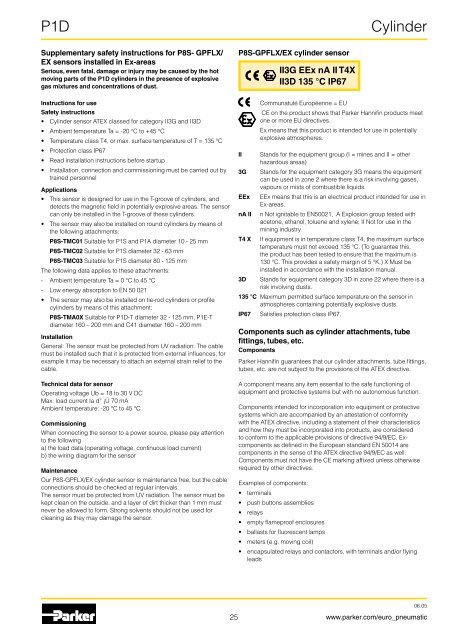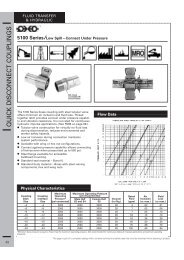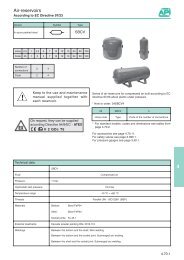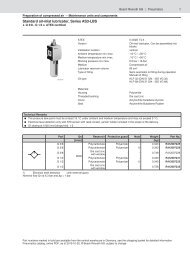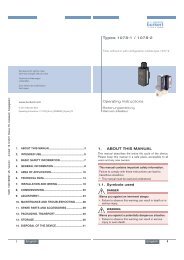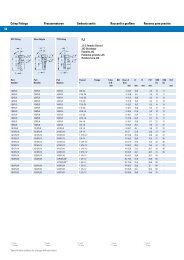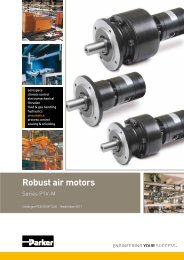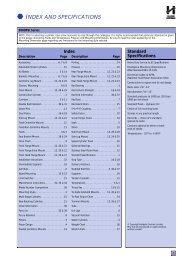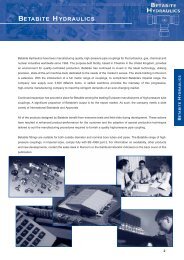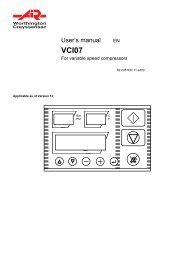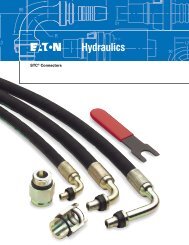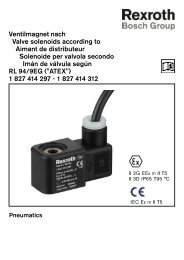Pneumatic cylinders - Duncan Rogers
Pneumatic cylinders - Duncan Rogers
Pneumatic cylinders - Duncan Rogers
- No tags were found...
Create successful ePaper yourself
Turn your PDF publications into a flip-book with our unique Google optimized e-Paper software.
P1DCylinderSupplementary safety instructions for P8S- GPFLX/EX sensors installed in Ex-areasSerious, even fatal, damage or injury may be caused by the hotmoving parts of the P1D <strong>cylinders</strong> in the presence of explosivegas mixtures and concentrations of dust.P8S-GPFLX/EX cylinder sensorII3G EEx nA II T4XII3D 135 °C IP67Instructions for useSafety instructions• Cylinder sensor ATEX classed for category II3G and II3D• Ambient temperature Ta = -20 °C to +45 °C• Temperature class T4, or max. surface temperature of T = 135 °C• Protection class IP67• Read installation instructions before startup• Installation, connection and commissioning must be carried out bytrained personnelApplications• This sensor is designed for use in the T-groove of <strong>cylinders</strong>, anddetects the magnetic field in potentially explosive areas. The sensorcan only be installed in the T-groove of these <strong>cylinders</strong>.• The sensor may also be installed on round <strong>cylinders</strong> by means ofthe following attachments:P8S-TMC01 Suitable for P1S and P1A diameter 10 - 25 mmP8S-TMC02 Suitable for P1S diameter 32 - 63 mmP8S-TMC03 Suitable for P1S diameter 80 - 125 mmThe following data applies to these attachments:- Ambient temperature Ta = 0 °C to 45 °C- Low energy absorption to EN 50 021• The sensor may also be installed on tie-rod <strong>cylinders</strong> or profile<strong>cylinders</strong> by means of this attachment:P8S-TMA0X Suitable for P1D-T diameter 32 - 125 mm, P1E-Tdiameter 160 – 200 mm and C41 diameter 160 – 200 mmInstallationGeneral: The sensor must be protected from UV radiation. The cablemust be installed such that it is protected from external influences, forexample it may be necessary to attach an external strain relief to thecable.Technical data for sensorOperating voltage Ub = 18 to 30 V DCMax. load current Ia d” ¡Ü 70 mAAmbient temperature: -20 °C to 45 °CCommissioningWhen connecting the sensor to a power source, please pay attentionto the followinga) the load data (operating voltage, continuous load current)b) the wiring diagram for the sensorMaintenanceOur P8S-GPFLX/EX cylinder sensor is maintenance free, but the cableconnections should be checked at regular intervals.The sensor must be protected from UV radiation. The sensor must bekept clean on the outside, and a layer of dirt thicker than 1 mm mustnever be allowed to form. Strong solvents should not be used forcleaning as they may damage the sensor.Communatuté Européenne = EUCE on the product shows that Parker Hannifin products meetone or more EU directives.Ex means that this product is intended for use in potentiallyexplosive atmospheres.II Stands for the equipment group (I = mines and II = otherhazardous areas)3G Stands for the equipment category 3G means the equipmentcan be used in zone 2 where there is a risk involving gases,vapours or mists of combustible liquids.EEx EEx means that this is an electrical product intended for use inEx-areas.nA II n Not ignitable to EN50021, A Explosion group tested withacetone, ethanol, toluene and xylene; II Not for use in themining industry.T4 X If equipment is in temperature class T4, the maximum surfacetemperature must not exceed 135 °C. (To guarantee this,the product has been tested to ensure that the maximum is130 °C. This provides a safety margin of 5 °K.) X Must beinstalled in accordance with the installation manual.3D Stands for equipment category 3D in zone 22 where there is arisk involving dusts.135 °C Maximum permitted surface temperature on the sensor inatmospheres containing potentially explosive dusts.IP67 Satisfies protection class IP67.Components such as cylinder attachments, tubefittings, tubes, etc.ComponentsParker Hannifin guarantees that our cylinder attachments, tube fittings,tubes, etc. are not subject to the provisions of the ATEX directive.A component means any item essential to the safe functioning ofequipment and protective systems but with no autonomous function.Components intended for incorporation into equipment or protectivesystems which are accompanied by an attestation of conformitywith the ATEX directive, including a statement of their characteristicsand how they must be incorporated into products, are consideredto conform to the applicable provisions of directive 94/9/EC. Excomponentsas defined in the European standard EN 50014 arecomponents in the sense of the ATEX directive 94/9/EC as well.Components must not have the CE marking affixed unless otherwiserequired by other directives.Examples of components:• terminals• push buttons assemblies• relays• empty flameproof enclosures• ballasts for fluorescent lamps• meters (e.g. moving coil)• encapsulated relays and contactors, with terminals and/or flyingleads2506.05www.parker.com/euro_pneumatic


